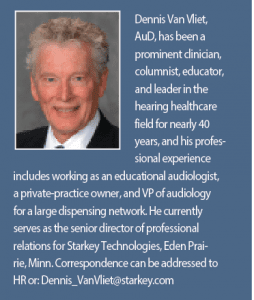Final Word | Hearing Review August 2014
By Dennis Van Vliet, AuD
I recently listened to a lecture by Curtis J. Alcock. Mr Alcock has a background in design and marketing, and transitioned to hearing care about 12 years ago. He is part of a family-run hearing care practice in the UK, and speaks about his beliefs on shaping the future of hearing care (also see Alcock and Douglas Beck’s cover story “Right Product; Wrong Message” in the April 2014 edition of The Hearing Review).
I found his points interesting and thought-provoking. As an example, Alcock offers that the mantra we often discuss—the idea that people wait a certain amount of time before pursuing hearing help—is counterproductive. He feels that discussing it validates the waiting—waiting for a certain amount of time, or waiting for a pain threshold to be crossed before acting. We should, instead, be discussing ways to make using hearing technology relevant to the wide range of individuals who could benefit from the help.
People adopt things when they are relevant to their lives. Apple products are a good example. Apple products are often so innovative that we don’t know that we could use them until we learn that they are relevant to our lives.
Alcock also talks about the need to change vocabulary. “Testing” hearing has a more negative air than a “hearing check-up.” “Hearing aid” falls into a disability category, while “hearing system” isn’t automatically categorized in a negative way. Discussing “stigma” reinforces the negative construct.
All of this led me to think quite a bit about how society may perceive certain aspects of others around them. I began to wonder if the stigma of hearing loss and hearing aids isn’t so deeply ingrained in our attitudes that we may have to own it, or at least accept it.
Alcock counters that attitudes are learned behavior, and we should be able to change them if we take appropriate action. Certainly, in the United States, smoking has changed from a stylish acceptable activity to unacceptable in a manner of decades. As dental care has progressed, false teeth are no longer an expected consequence of aging. Eyewear is now as much of a fashion statement as a method for correcting vision.
Can we get to the point where hearing aids, like glasses, are the symbol of a solution, rather than a problem? More importantly, when I meet someone for the first time and tell them what I do for a living, will I no longer be treated to their dramatic charade of hunching over, scowling, holding a cupped hand to their ear, and shouting “Eh?”
Delivering Clear Messages
We do have much more to work with than when many of us started in the field. Unsightly “Frankenstein knob” full-shell ITEs have been largely replaced by more discreet custom products that offer better performance, comfort, and performance. Huge BTEs that looked like fenders from a 1930s antique car are now smaller, lighter, and generally more accepted, especially with thin-tube coupling when appropriate.
Attitudes, however, do need to change, and we should take stock of the marketing messages we offer, and the language we use. For example:
Hearing: In counseling, we typically describe evaluation results in terms of a “hearing loss.” “Hearing ability” can communicate the message just as well. A narrative similar to the following introduces the facts without branding the person with a negative diagnosis:
“We see that you can detect lower pitched sounds at very soft levels. Your hearing ability is such that higher pitched sounds require somewhat louder sounds for detection. Here’s how we can improve things for you…”
The differences are subtle, but may make a difference in how the message is received.
Cognition: While we see a number of indicators that hearing loss and dementia are associated, there is less evidence that there is a direct causative link. The link may be there, but the evidence isn’t great at this point. In my mind, I’m not sure that tying dementia and hearing loss together directly is a desirable path to take because of the negative context, but we should still create a dialog to allow the connection to be made by the public.
Just as we want to talk about hearing ability, hearing health, and staying connected with life and loved ones, we probably should emphasize the role of cognitive strength in supporting those concepts. The dementia-hearing loss connection will still be made by the consumer, but in an overall positive, healthy way. Try this:
“A properly fitted hearing system will not only provide the additional hearing you need, but will assure the good cognitive strength you depend upon in difficult listening situations.”
The listener will make the connection about hearing and cognitive health with this positive message.

Original citation for this article: Van Vliet D. Better messages on better hearing: Shaping images and attitudes for the benefit of our patient. Hearing Review. 2014;21(8):50.





